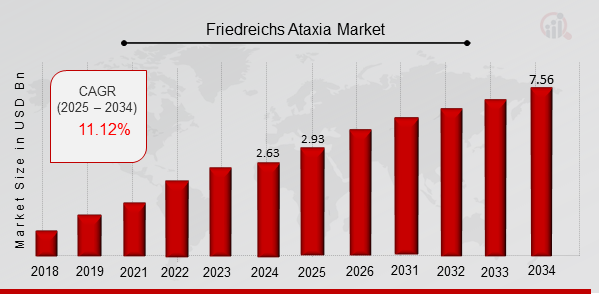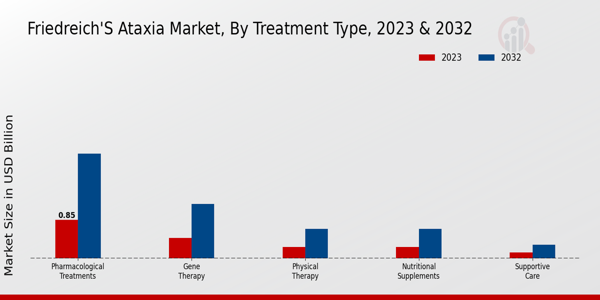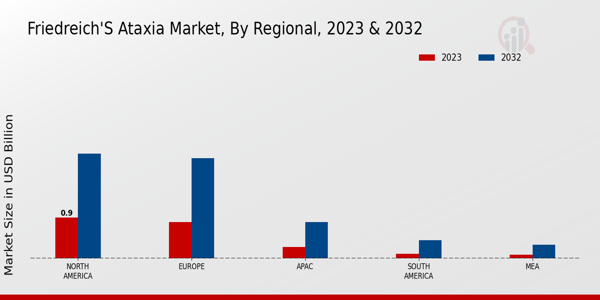Friedreich's Ataxia Market Overview
As per MRFR analysis, the Friedreichs Ataxia Market Size was estimated at 2.63 (USD Billion) in 2024. The Friedreichs Ataxia Market Industry is expected to grow from 2.93 (USD Billion) in 2025 to 7.56 (USD Billion) till 2034, at a CAGR (growth rate) is expected to be around 11.12% during the forecast period (2025 - 2034).
Key Friedreich's Ataxia Market Trends Highlighted
The Friedreich’s Ataxia Market is driven by several key factors, including the increasing prevalence of the disease and a growing understanding of its genetic basis. As research progresses, the push for more effective therapies has gained momentum. Collaboration between pharmaceutical companies, academic institutions, and patient advocacy groups has become essential in advancing drug development. The focus on personalized medicine and gene therapy has opened new avenues for treatment, boosting optimism in the medical community and market players alike. Opportunities exist in the development of innovative treatments that target the underlying causes of Friedreich's Ataxia rather than just managing symptoms.As awareness of the disease increases, so does the potential for better diagnosis and timely intervention. The implementation of novel drug delivery systems and biologics presents additional prospects. Furthermore, the rise of telemedicine and digital health solutions can improve patient monitoring and engagement and support the clinical trial process. Recent trends show an upward trajectory in both research funding and clinical trial activity. With advancements in gene editing techniques, firms are exploring therapies that could significantly alter disease progression. The role of biomarkers in clinical trials is being emphasized to enhance the selection of appropriate patient populations and tailor treatments effectively.Additionally, the integration of artificial intelligence in drug discovery is reshaping the landscape, enabling faster and more efficient development processes. Collectively, these trends point to a dynamic environment in the Friedreich's Ataxia market, characterized by innovation and collaboration, aimed at improving care and quality of life for patients.

Source: Primary Research, Secondary Research, MRFR Database and Analyst Review
Friedreich's Ataxia Market Drivers
Rising Awareness and Diagnosis of Friedreich's Ataxia
The increasing awareness about Friedreich's Ataxia among healthcare professionals and the general public plays a crucial role in driving the Friedreich’s Ataxia Market Industry. With advancements in genetic testing and diagnostics, more individuals are being diagnosed early in their condition, leading to timely intervention and management of symptoms. This heightened awareness of the disease symptomatology serves to facilitate a better understanding of the disorder, ensuring that patients receive appropriate medical care at the right time.Moreover, advocacy from patient groups has heightened the focus on this rare genetic disorder, encouraging funding for research and promoting initiatives aimed at educating stakeholders about the condition. As more families and individuals learn about Friedreich's Ataxia, there is an increase in demand for treatment options, therapies, and clinical trials, which in turn support the growth of the Friedreich’s Ataxia Market Industry. Furthermore, as public and private organizations continue to champion awareness campaigns, the number of diagnosed cases is expected to rise, contributing positively to the overarching market dynamics.This creates a self-reinforcing cycle where increased diagnosis leads to greater awareness, and greater awareness drives further research investment and development of therapies, thereby propelling market growth.
Advancements in Therapeutic Options
The Friedreich’s Ataxia Market Industry is significantly impacted by advancements in therapeutic options designed to address the symptoms and manifestations of the disease. Recent innovations in treatment modalities, ranging from gene therapy to novel pharmacological agents, are expanding the arsenal of interventions available to patients. The pursuit of effective therapies has led to a surge in clinical trials, with many promising therapies moving through the regulatory pipeline.These advancements not only offer hope for improved patient outcomes but also attract investments and funding from biopharmaceutical companies eager to develop effective solutions for this previously underserved condition. The collaborative efforts among medical researchers, pharmaceutical companies, and academic institutions to enhance treatment availability are expected to sustain momentum in market growth as new therapeutic options become accessible and part of standard care.
Increasing Research Funding and Investment
Another key driver for the Friedreich’s Ataxia Market Industry is the increasing funding and investment directed towards research and development of treatments for this rare disease. With the rising interest from both public and private sectors, there is a significant push to explore new avenues for therapy that can effectively address the underlying genetic causes of Friedreich's Ataxia. This investment climate encourages innovation and the emergence of new treatment methodologies, which would contribute to better management options for patients and support the overall growth of the market.As research funding continues to grow, it fosters partnerships between stakeholders, leading to the accelerated development of breakthrough therapies.
Friedreich's Ataxia Market Segment Insights:
Friedreich's Ataxia Market Treatment Type Insights
The Friedreich’s Ataxia Market is currently experiencing significant growth within the Treatment Type segment, showing robust revenue potential driven by various therapeutic approaches. In 2023, the Pharmacological Treatments segment leads the market, valued at 0.85 USD Billion, and is projected to escalate substantially to 2.3 USD Billion by 2032, showcasing its dominant position. This segment captures the majority holding due to the increasing efficacy of drug therapies aimed at alleviating symptoms and slowing disease progression. Following closely, Gene Therapy is also making substantial strides in the market, valued at 0.45 USD Billion in 2023 and expected to increase to 1.2 USD Billion by 2032.This approach holds significant promise, as it targets the underlying genetic causes of Friedreich's Ataxia, setting the stage for transformative treatments. Physical Therapy and Nutritional Supplements, both valued at 0.25 USD Billion in 2023 with projections rising to 0.65 USD Billion by 2032, are crucial for rehabilitation and supportive care, helping to maintain mobility and overall health, thus reflecting their vital role in patient management despite lower market shares. Supportive Care, while being the smallest segment at 0.13 USD Billion in 2023, shows potential for growth, reaching 0.3 USD Billion by 2032, highlighting the importance of holistic patient care.Overall, the varied approaches within the Friedreich’s Ataxia Market segmentation emphasize a comprehensive management strategy for patients, where pharmacological and gene therapies currently dominate, but also underscore the essential roles that physical, nutritional, and supportive therapies play in enhancing patient quality of life. This dynamic landscape presents opportunities and challenges as stakeholders look to invest in innovative treatment avenues, paving the way for advancements in this niche but critical area of health.

Source: Primary Research, Secondary Research, MRFR Database and Analyst Review
Friedreich's Ataxia Market Diagnosis Methods Insights
The Friedreich’s Ataxia Market is expected to experience significant growth within the Diagnosis Methods segment, reflecting an overall market valuation of 2.13 billion USD in 2023. This segment encompasses various methodologies utilized to diagnose Friedreich's Ataxia, highlighting the importance of precise and early diagnostic tools in enhancing patient outcomes. Clinical Examination and Neurological Assessment are crucial as they allow healthcare professionals to evaluate symptoms and neurological function effectively, making them foundational in the diagnostic process.Genetic Testing plays a significant role by confirming the presence of mutations associated with the disorder, which is essential for accurate diagnosis. Similarly, Magnetic Resonance Imaging (MRI) contributes valuable imaging data that can reveal neurological changes, aiding in differential diagnosis. Electromyography further enhances diagnostic capabilities by assessing muscle function, providing insights into the implications of nerve damage associated with Friedreich's Ataxia. The diversity within this segment illustrates a comprehensive approach to diagnosis, with increasing integration of technology and genetic understanding driving the market growth.The Friedreich’s Ataxia Market statistics underscore that advancements in diagnosis are essential for improving treatment options and patient management strategies.
Friedreich's Ataxia Market Patient Age Group Insights
The Friedreich’s Ataxia Market, valued at 2.13 USD Billion in 2023, displays a noteworthy focus on the Patient Age Group segment, which encompasses the Pediatric, Adolescent, Adult, and Elderly categories. This segmentation reveals critical insights into how different age groups are impacted by Friedreich's Ataxia, with pediatric cases often being diagnosed early, leading to a growing need for specialized healthcare solutions tailored to children. The adolescent age group also plays a significant role as these patients typically experience the onset of symptoms during their teenage years, driving the demand for targeted treatment and supportive therapies.Adults constitute a major portion of the market due to the chronic nature of Friedreich's Ataxia, with many seeking ongoing care to manage their condition effectively. The elderly segment, while smaller, is becoming increasingly important due to the need for age-appropriate interventions as life expectancy rises. Overall, the insights drawn from the Friedreich’s Ataxia Market segmentation highlight the intricate dynamics and specific demands across various age groups, underscoring the market's evolution while reflecting broader trends in healthcare and support for individuals affected by this condition.
Friedreich's Ataxia Market End User Insights
The Friedreich’s Ataxia Market is witnessing substantial growth driven by an increasing focus on effective treatment strategies, primarily within various End-user segments. As of 2023, the market is valued at 2.13 USD billion, highlighting a significant investment in the healthcare infrastructure that caters to Friedreich's Ataxia patients. Hospitals and clinics remain crucial, offering specialized care and advanced treatment options that cater to the needs of patients. Home care services are gaining traction as they provide personalized attentiveness and support for individuals preferring treatment in familiar settings.Furthermore, research institutes play a vital role in advancing potential therapies, contributing to innovative solutions through dedicated studies. The evolving landscape of the Friedreich’s Ataxia Market segmentation reflects a trend toward integrated care models that enhance patient outcomes, focusing on holistic treatment approaches. The growth drivers in this market stem from rising patient awareness, increased healthcare expenditure, and an ongoing commitment to research and development in effective therapies, presenting significant opportunities that encourage further investments in improving patient care.Analyzing Friedreich’s Ataxia Market data reveals that advancements in treatment methodologies are crucial for addressing the challenges faced by individuals and healthcare providers alike.
Friedreich's Ataxia Market Regional Insights
The Friedreich’s Ataxia Market revenue showcases distinct regional dynamics, with a total market value reaching 2.13 USD Billion in 2023. North America leads with a significant market share, valued at 0.9 USD Billion, expected to grow to 2.3 USD Billion by 2032, indicating its dominant position driven by advanced medical research and strong healthcare infrastructure. Europe follows closely with a market valuation of 0.8 USD Billion in 2023, anticipated to reach 2.2 USD Billion by 2032, reflecting substantial investments in therapeutic developments.
APAC holds a smaller share, with a valuation of 0.25 USD Billion in 2023, projected to increase to 0.8 USD Billion, driven by rising healthcare access and awareness. South America and MEA have comparatively lower valuations of 0.1 USD Billion and 0.08 USD Billion, respectively, in 2023, though opportunities for growth exist, especially in improving healthcare systems. The overall Friedreich’s Ataxia Market data suggests a well-defined segmentation with notable growth drivers, such as the increasing prevalence of genetic disorders and a focus on innovative treatment solutions across these regions, highlighting significant opportunities in the industry landscape.The aforementioned market statistics emphasize the varying capabilities and potential of each regional market, with North America and Europe demonstrating robust advantages.

Source: Primary Research, Secondary Research, MRFR Database and Analyst Review
Friedreich's Ataxia Market Key Players and Competitive Insights:
The Friedreich’s Ataxia Market is characterized by its evolving landscape driven by advancements in research and development for rare neurological disorders. As awareness of Friedreich’s Ataxia grows, numerous players are increasingly active in developing therapies that target the underlying causes of the condition. The market is highly competitive, with companies striving to gain a foothold by innovating new treatment options, improving patient outcomes, and enhancing the quality of life for those affected. Partnerships between biopharmaceutical companies and research institutions are common as stakeholders seek to leverage collective expertise to navigate the complexities of Friedreich's Ataxia. Additionally, regulatory approval pathways remain crucial in shaping market dynamics, as timely product launches can significantly influence competitive positioning, particularly in an area that lacks established therapies.Ionis Pharmaceuticals holds a strategic position within the Friedreich’s Ataxia Market, leveraging its cutting-edge technology platform that focuses on the modification of RNA to develop potential treatments. The company's expertise in antisense oligonucleotide drugs provides a unique approach to targeting specific genetic mutations associated with the disease, offering hope to patients with unaddressed needs. Ionis Pharmaceuticals is known for its robust pipeline, reflecting its commitment to addressing Friedreich's Ataxia with innovative solutions, thereby contributing to its competitive edge in the marketplace. The company's strong research collaboration initiatives with leading academic institutions enhance its credibility and allow it to access vital scientific insights, which can expedite the drug development process. This strategic positioning, driven by high-quality research outcomes and innovative therapeutic approaches, solidifies Ionis Pharmaceuticals as a frontrunner in addressing the complexities of Friedreich's Ataxia.Pfizer is another prominent player within the Friedreich’s Ataxia Market, focusing on utilizing its extensive resources and experience in the pharmaceutical industry to influence treatment paradigms. The company's commitment to rare diseases, particularly neurological disorders, is evident in its investment in research and clinical trials aimed at addressing unmet medical needs. Pfizer’s established reputation, coupled with its large-scale manufacturing capabilities, enables the company to efficiently bring potential therapies to the market. Furthermore, Pfizer engages in strategic collaborations and partnerships that enhance its research capabilities and broaden its therapeutic portfolio, fostering a dynamic approach to developing solutions for Friedreich's Ataxia. With a focus on innovation and patient-centric solutions, Pfizer aims to strengthen its presence in Friedreich's Ataxia Market, driving advancements in treatment options and improving the quality of life for individuals affected by this challenging condition.
Key Companies in the Friedreich's Ataxia Market Include:
- Ionis Pharmaceuticals
- Pfizer
- Eli Lilly
- Bristol Myers Squibb
- Celgene
- Vertex Pharmaceuticals
- Genzyme
- Horizon Therapeutics
- Amgen
- Alnylam Pharmaceuticals
- Enanta Pharmaceuticals
- Sarepta Therapeutics
- AveXis
- Novartis
- Sanofi
Friedreich's Ataxia Market Industry Developments
The Friedreich’s Ataxia Market is experiencing significant developments, particularly with advancements in genetic therapies and innovative treatment options. Companies such as Ionis Pharmaceuticals and Pfizer are pushing the boundaries of research, focusing on gene therapy and antisense oligonucleotides. Eli Lilly and Bristol Myers Squibb are exploring new pathways for drug delivery systems that target neurological manifestations of the disease. The market has also seen a surge in interest from investors following promising Phase 2 trial results released by biotech firms like Sarepta Therapeutics and Alnylam Pharmaceuticals, which are working on RNA interference therapies specifically for Friedreich's Ataxia. Recent mergers and acquisitions also signal a strategic consolidation, with firms like Novartis and Amgen looking to enhance their portfolios. Furthermore, the market valuation of organizations within this sector is on an upward trajectory, attributed to increased funding and collaborative research efforts aimed at accelerating treatment timelines. Sanofi and Celgene are actively participating in these dynamics, targeting novel interventions that could lead to more effective management of the disease. As these developments unfold, they are likely to shape the future landscape of Friedreich's Ataxia treatments and market strategies significantly.
Friedreich's Ataxia Market Segmentation Insights
- Friedreich's Ataxia Market Treatment Type Outlook
- Pharmacological Treatments
- Gene Therapy
- Physical Therapy
- Nutritional Supplements
- Supportive Care
- Friedreich's Ataxia Market Diagnosis Methods Outlook
- Clinical Examination
- Genetic Testing
- Magnetic Resonance Imaging
- Electromyography
- Neurological Assessment
- Friedreich's Ataxia Market Patient Age Group Outlook
- Pediatric
- Adolescent
- Adult
- Elderly
- Friedreich's Ataxia Market End User Outlook
- Hospitals
- Clinics
- Home Care
- Research Institutes
| Report Attribute/Metric |
Details |
|
Market Size 2024
|
2.63 (USD Billion)
|
|
Market Size 2025
|
2.93 (USD Billion)
|
|
Market Size 2034
|
7.56 (USD Billion)
|
|
Compound Annual Growth Rate (CAGR)
|
11.12% (2025 - 2034)
|
|
Report Coverage
|
Revenue Forecast, Competitive Landscape, Growth Factors, and Trends
|
|
Base Year
|
2024
|
|
Market Forecast Period
|
2025 - 2034
|
|
Historical Data
|
2020 - 2024
|
| Market Forecast Units |
USD Billion |
| Key Companies Profiled |
Ionis Pharmaceuticals, Pfizer, Eli Lilly, Bristol Myers Squibb, Celgene, Vertex Pharmaceuticals, Genzyme, Horizon Therapeutics, Amgen, Alnylam Pharmaceuticals, Enanta Pharmaceuticals, Sarepta Therapeutics, AveXis, Novartis, Sanofi |
| Segments Covered |
Treatment Type, Diagnosis Methods, Patient Age Group, End User, Regional |
| Key Market Opportunities |
R for gene therapies, Innovative drug development, Increased awareness and diagnosis, Collaborative clinical trials, Growth in patient advocacy networks |
| Key Market Dynamics |
Increasing patient population, Growing research funding, Advancements in gene therapy, Rising awareness and advocacy, Limited treatment options |
| Countries Covered |
North America, Europe, APAC, South America, MEA |
Frequently Asked Questions (FAQ) :
The Friedreich’s Ataxia Market is expected to be valued at 7.56 USD Billion by 2034.
The expected CAGR for the Friedreich’s Ataxia Market from 2025 to 2034 is 11.12%.
North America is expected to hold the largest market share, valued at 2.3 USD Billion by 2032.
The market size for Pharmacological Treatments is expected to reach 2.3 USD Billion by 2032.
Significant players in the market include Ionis Pharmaceuticals, Pfizer, and Bristol Myers Squibb.
The expected market size for Gene Therapy is projected to reach 1.2 USD Billion by 2032.
The Friedreich's Ataxia Market in the APAC region is expected to grow to 0.8 USD Billion by 2032.
The projected size for Supportive Care is expected to be 0.3 USD Billion by 2032.
The market presents growth opportunities in emerging therapies and increased awareness of the condition.
The expected market size for Physical Therapy is projected to be 0.65 USD Billion by 2032.

















